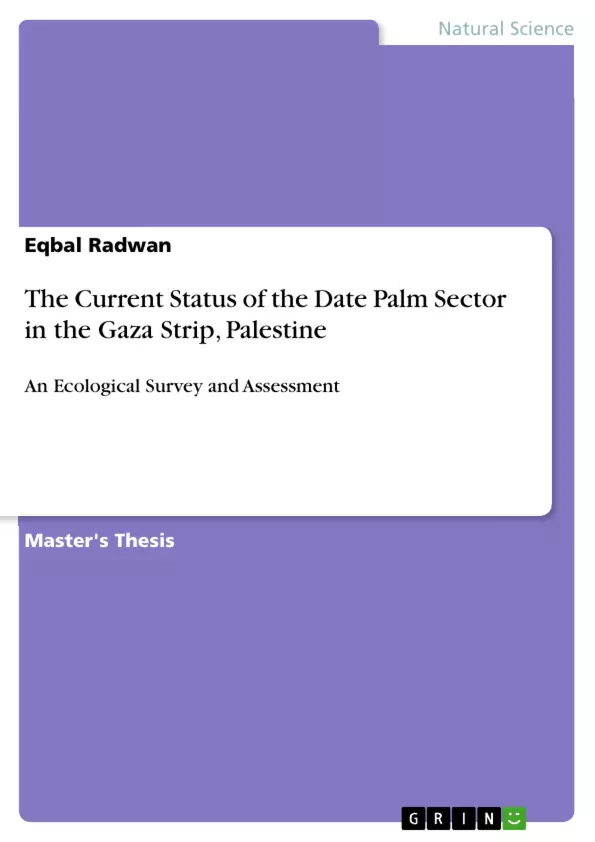Date Palm is considered one of the most important fruit crops in Palestine. Its cultivation has been known for thousands of years. It has a major socio-economic importance due to its commercial, nutritional, environmental, social, health and religious values. Because of it is minimum water demand and tolerates to both harsh weather and high levels of salinity, it is a strategic crop in the Gaza Strip, which suffers from such conditions. The Red Palm Weevil has recently become one of the major pests attacking the Date Palm and it causes sever losses to Gazan farmers. This book, therefore, will provides useful information about the status of the Date Palm in Gaza Strip to both responsible authorities and the public. This will help improve good sustainable development of the Date Palm sector locally.
Inhaltsverzeichnis (Table of Contents)
- Chapter 1 Introduction
- 1.1 Overview
- 1.2 Problem
- 1.3 Objectives
- 1.4 Significance
- Chapter 2 Literature Review
- 2.1 History of Date Palm
- 2.2 Geographic distribution of Date Palm
- 2.3 Worldwide production of Date Palm
- 2.4 Botanical description of Date Palm
- 2.5 Reproductive biology of the Date Palm
- 2.6 Cultivation of Date Palm
- 2.7 Harvest and postharvest handling of Date Palm
- 2.8 Uses of Dates and Date Palm
- 2.9 Date Palm cultivars grown in the MENA
- 2.10 Pests and diseases of Date Palm
- 2.11 Date Palm in Palestine
- 2.12 Previous studies on Date Palm
- Chapter 3 Methodology
- 3.1 Materials and Methods
- 3.1.1 Study area
- 3.1.2 Site and institutional visits
- 3.1.3 Outbreak and control of Red Palm Weevil
- 3.1.4 Structured and semi-structured interviews
- 3.1.5 Questionnaire design and application
- 3.1.6 Photography
- 3.1.7 Data analysis
Zielsetzung und Themenschwerpunkte (Objectives and Key Themes)
This study aims to investigate the current status of the Date Palm tree and its uses in the Gaza Strip, Palestine. It examines various aspects of the sector including cultivation practices, production, marketing, and threats faced by the Date Palm industry in the region. The study seeks to provide an insightful analysis of the Date Palm sector in the Gaza Strip, highlighting its importance and challenges, while offering recommendations for its sustainable development.
- The current status of Date Palm cultivation in the Gaza Strip, including the number of trees and cultivars.
- The impact of the Red Palm Weevil (RPW) on Date Palm production and the various control techniques used.
- The socioeconomic importance of the Date Palm sector, including its contribution to food security, employment, and handicraft industries.
- The threats facing the Date Palm sector in the Gaza Strip, including Israeli occupation and pest outbreaks.
- Recommendations for the sustainable development of the Date Palm sector in the Gaza Strip.
Zusammenfassung der Kapitel (Chapter Summaries)
Chapter 1 provides an overview of the study, outlining the problem statement, objectives, and significance of the research. This chapter sets the stage for the comprehensive examination of the Date Palm sector in the Gaza Strip. Chapter 2 presents a thorough literature review on various aspects of Date Palm, covering its history, geographic distribution, worldwide production, botanical description, reproductive biology, cultivation practices, harvest and postharvest handling, uses, cultivars, pests and diseases, and previous research related to this valuable crop. This chapter provides a solid foundation of knowledge on Date Palm, essential for understanding the specific context of the Gaza Strip. Chapter 3 details the methodology used in the study, including the study area, site and institutional visits, outbreak and control of Red Palm Weevil, structured and semi-structured interviews, questionnaire design and application, photography, and data analysis. This chapter provides a clear and transparent explanation of the research methods employed to collect and analyze data related to the Date Palm sector in the Gaza Strip.
Schlüsselwörter (Keywords)
The study focuses on various aspects of the Date Palm sector in the Gaza Strip, encompassing keywords such as Date Palm, cultivars, Red Palm Weevil, public uses, and the Gaza Strip itself. The research explores the importance of this resilient crop, its cultivation practices, production challenges, and its significant socioeconomic value for the Palestinian community. The study delves into the impacts of threats, such as the Red Palm Weevil and Israeli occupation, on the sector's sustainability. Key themes emerge from the study, including the need for sustainable development of the Date Palm sector, the importance of pest management, and the role of the Date Palm in contributing to food security and economic well-being in the Gaza Strip.
- Citation du texte
- Eqbal Radwan (Auteur), 2017, The Current Status of the Date Palm Sector in the Gaza Strip, Palestine, Munich, GRIN Verlag, https://www.grin.com/document/358860



